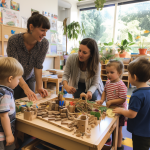Explanation of The Characteristics of Effective Learning
Playing and exploring
The key ways children learn are through play and exploration. Vygotsky, a psychologist who specialises in child development stated that “in play the child operates at their highest level beyond his average age, above his daily behaviour; in play it is as though he were a head taller than himself.”
Finding out and exploring
Babies begin to understand the world around them through exploring their surroundings, the people around them and using all of their senses. Gopnik et al refer to babies and toddlers as young scientists as they repeat actions to establish an idea about an object. This allows them to understand their own actions and the consequences of those actions.
Playing with what they know
Right from birth babies play and explore in order to build knowledge, skills and an understanding of the world around them. They will also start to imagine possibilities, therefore helping them to play with what they know.
Being willing to ‘have a go’
Play time gives children the opportunity to try new things, take risks, make mistakes and challenge themselves. Children are willing to give anything a go, in order to discover the world around them. Children become more confident with play as it is something they are in control of. Play helps us come to terms with fears, dangers, and the unpredictability of the world and human relationships. As adults, we can support and facilitate play, but if we take control of it, it is no longer the child’s agenda and they are unlikely to learn.
Active Learning
The second characteristic of learning is about being mentally active, not physically active, which is also important. It involves children being deeply involved and concentrating. It motivates children and allows them to get satisfaction for completing a task.
Being involved and concentrating
Motivation is the key to concentration, which is linked to involvement. The research of Ferre Laevers has shown that when children are deeply involved in what they are doing, it is likely that deep-level learning is taking place. And, ‘if deep-level learning is taking place, a person is operating at the limits of their “zone of proximal development”’. The times when children choose what they want to play with, follow their natural curiosity and train of thought then deep involvement is likely to happen.
Keeping on trying
Persistence is about being motivated to master something new. Children will try new ways to solve the problem, praise is key to helping children to identify their success and helps them to bounce back from difficulties.
Enjoying achieving what they set out to do
The emphasis here is on the way children achieve their own goals. This will mean the child is fully dedicated and the motivation is intrinsic, coming from within. If the motivation is extrinsic, arising externally (such as parents pressuring them to do well at something) then once the reward has been achieved there is little motivation to continue.
Creating and thinking Critically
Creating and thinking critically are fundamental processes in making sense of experiences and developing thought. Creativity in this sense is about thinking flexibly and developing our imagination. Critical thinking allows us to organise thoughts, come up with new strategies and problem solve. It also helps us to reflect and therefore learn.
Having their own ideas
Children also need to have the ability to create ideas, therefore play and exploration are vital. We should encourage children to come up with ideas and put them into practice. Being inventive allows children to find new problems as they seek challenge and to explore ways of solving these.
Making links
Babies are constantly making links between new experiences and what they have already learnt. Babies connect these through play and later on in life start to communicate verbally.
Choosing ways to do things
This involves the way children make choices and the way they go about following an instruction etc. Tickell believes it is involves ‘making choices and decisions about how to approach a task, planning and monitoring what to do, and being able to change strategies’.
















4 thoughts on “The Characteristics of Effective Learning”
Please could you email me this also it would be very useful for my staff many thanks
Thank you for the information you share to improve practice, very informative.
Please could you email this as like to read in my own time
We have emailed you the link